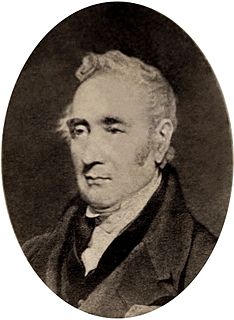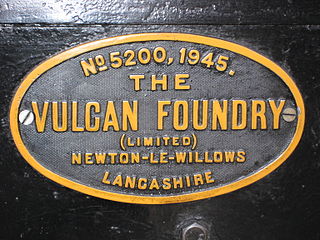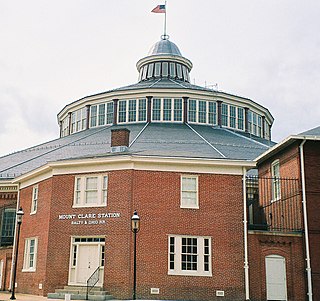
George Stephenson was an English civil engineer and mechanical engineer. Renowned as the "Father of Railways", Stephenson was considered by the Victorians a great example of diligent application and thirst for improvement. Self-help advocate Samuel Smiles particularly praised his achievements. His chosen rail gauge, sometimes called "Stephenson gauge", was the basis for the 4 feet 8+1⁄2 inches (1.435 m) standard gauge used by most of the world's railways.

Stephenson's Rocket is an early steam locomotive of 0-2-2 wheel arrangement. It was built for and won the Rainhill Trials of the Liverpool and Manchester Railway (L&MR), held in October 1829 to show that improved locomotives would be more efficient than stationary steam engines.

The Liverpool and Manchester Railway (L&MR) was the first inter-city railway in the world. It opened on 15 September 1830 between the Lancashire towns of Liverpool and Manchester in England. It was also the first railway to rely exclusively on locomotives driven by steam power, with no horse-drawn traffic permitted at any time; the first to be entirely double track throughout its length; the first to have a true signalling system; the first to be fully timetabled; and the first to carry mail.

The Science and Industry Museum in Manchester, England, traces the development of science, technology and industry with emphasis on the city's achievements in these fields. The museum is part of the Science Museum Group, a non-departmental public body of the Department for Digital, Culture, Media and Sport, having merged with the National Science Museum in 2012.

The history of rail transport began in the prehistoric times. It can be divided into several discrete periods defined by the principal means of track material and motive power used.

The Baltimore and Ohio Railroad was the first common carrier railroad and the oldest railroad in the United States, with its first section opening in 1830. Merchants from Baltimore, which had benefited to some extent from the construction of the National Road early in the century, wanted to do business with settlers crossing the Appalachian Mountains. The railroad faced competition from several existing and proposed enterprises, including the Albany-Schenectady Turnpike, built in 1797, the Erie Canal, which opened in 1825, and the Chesapeake and Ohio Canal. At first, the B&O was located entirely in the state of Maryland; its original line extending from the port of Baltimore west to Sandy Hook, Maryland, opened in 1834. There it connected with Harper's Ferry, first by boat, then by the Wager Bridge, across the Potomac River into Virginia, and also with the navigable Shenandoah River.

The Vulcan Foundry Limited was an English locomotive builder sited at Newton-le-Willows, Lancashire.

The B&O Railroad Museum is a museum exhibiting historic railroad equipment in Baltimore, Maryland. The Baltimore and Ohio Railroad (B&O) company originally opened the museum on July 4, 1953 with the name of the Baltimore & Ohio Transportation Museum. It has been called one of the most significant collections of railroad treasures in the world and has the largest collection of 19th-century locomotives in the U.S. The museum is located in the Baltimore and Ohio Railroad's old Mount Clare Station and adjacent roundhouse, and retains 40 acres of the B&O's sprawling Mount Clare Shops site, which is where, in 1829, the B&O began America's first railroad and is the oldest railroad manufacturing complex in the United States.

This is a list of the earliest railroads in North America, including various railroad-like precursors to the general modern form of a company or government agency operating locomotive-drawn trains on metal tracks.

The Philadelphia, Wilmington and Baltimore Railroad (PW&B) was an American railroad that operated from 1836 to 1881. Formed as a result of the merger of four small lines dating from the earliest days of American railroading in the late 1820s and early 1830s, it was purchased by the Pennsylvania Railroad (PRR) in 1881, becoming part of their main line in 1902.

Tom Thumb was the first American-built steam locomotive to operate on a common-carrier railroad. It was designed and constructed by Peter Cooper in 1829 to convince owners of the newly formed Baltimore and Ohio Railroad (B&O) to use steam engines; it was not intended to enter revenue service. It is especially remembered as a participant in a perhaps mythical race with a horse-drawn car, which the horse won after Tom Thumb suffered a mechanical failure. However, the demonstration was successful, and the railroad committed to the use of steam locomotion and held trials in the following year for a working engine.

Henry Booth was a corn merchant, businessman and engineer particularly known as one of the key people behind the construction and management of the pioneering Liverpool and Manchester Railway (L&M), the world's first steam railway conducting both scheduled passenger services and freight.
The history of rail transport in Great Britain to 1830 covers the period up to the opening of the Liverpool and Manchester Railway, the world's first intercity passenger railway operated solely by steam locomotives. The earliest form of railways, horse-drawn wagonways, originated in Germany in the 16th century. Soon wagonways were also built in Britain. However, the first use of steam locomotives was in Britain. The invention of wrought iron rails, together with Richard Trevithick's pioneering steam locomotive meant that Britain had the first modern railways in the world.

The Baltimore and Ohio Ellicott City Station Museum in Ellicott City, Maryland, is the oldest remaining passenger train station in the United States, and one of the oldest in the world. It was built in 1830 as the terminus of the Baltimore and Ohio Railroad line from Baltimore to the town then called Ellicott's Mills, and a facility to service steam locomotives at the end of the 13-mile (21 km) run. The station, a National Historic Landmark, is now used as a museum.

The Baltimore Terminal Subdivision is a railroad line owned and operated by CSX Transportation in the U.S. state of Maryland. The line runs from Baltimore to Halethorpe along the original Baltimore and Ohio Railroad (B&O) line, one of the oldest rail lines in the United States and the first passenger railroad line. At its east (north) end, it connects with the Philadelphia Subdivision; its west (south) end has a junction with the Capital Subdivision and the Old Main Line Subdivision.
This article lists events relating to rail transport that occurred during the 1780s.














